In the bustling world of culinary mastery, where sizzling skillets orchestrate symphonies of flavors and tantalizing aromas dance through the air, the choice of pans becomes as crucial as the ingredients themselves.
Picture the seasoned chef, a maestro of the kitchen, wielding an array of pans like instruments in a grand culinary concerto. But amidst the cacophony of options, which pans do these culinary virtuosos truly swear by?
Step into the captivating realm where craftsmanship meets creativity, as we unveil the secrets behind the pans that ignite the flames of culinary excellence.
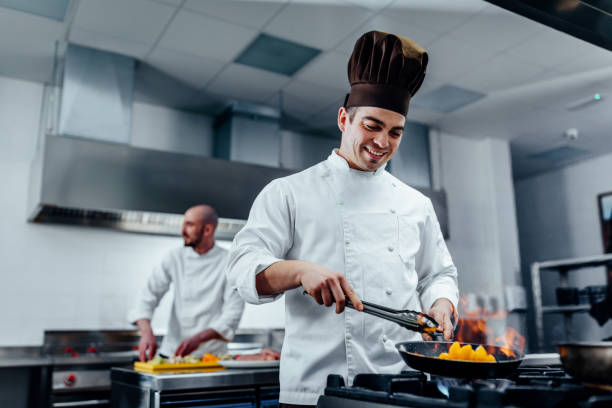
Who Are The Chefs?
Chefs are skilled culinary professionals who possess expertise in the art and science of cooking. They are responsible for creating, preparing, and presenting a wide variety of dishes in restaurants, hotels, catering companies, and other food establishments.
Chefs typically undergo extensive training in culinary arts, learning about food safety, nutrition, kitchen management, and various cooking techniques. They often start their careers as apprentices or line cooks, gradually advancing to higher positions such as sous chefs, executive chefs, and even celebrity chefs.
Chefs are passionate about food and flavor combinations, constantly experimenting with ingredients and recipes to create unique and delicious dishes.
Beyond their culinary skills, chefs must also possess strong leadership and organizational abilities to manage kitchen staff, coordinate meal services, and ensure that dishes are prepared efficiently and to the highest standards.
Chefs play a crucial role in shaping the dining experience, delighting customers with their culinary creations while upholding the reputation and success of the establishments they work for.
What Pans Do Chefs Use
Professional chefs commonly use a variety of pans in their kitchens, including stainless steel, cast iron, non-stick, and copper pans.
Chefs use a variety of pans depending on the specific requirements of the dishes they are preparing and their personal preferences. Some common types of pans found in a professional kitchen include:
1. Saucepans
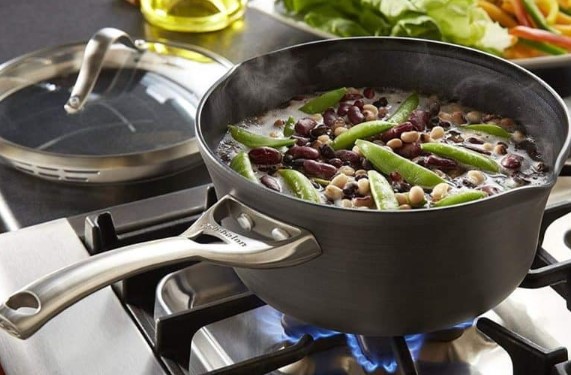
Saucepans are a staple in any chef’s kitchen arsenal. These versatile pots feature tall, straight sides and a long handle, often accompanied by a lid. Chefs use saucepans for a wide range of tasks, from simmering sauces and cooking grains to boiling vegetables and heating liquids.
The tall sides help prevent splattering, while the even heat distribution ensures that sauces and liquids cook evenly without scorching.
Saucepan sizes vary to accommodate different volumes of food, ranging from small one-quart pots for heating up a single portion of sauce to larger six-quart pots for making large batches of soups or stocks.
Chefs often prefer saucepans made from materials like stainless steel, aluminum, or copper, as these materials offer excellent heat conductivity and durability. Saucepans with non-stick coatings are popular for cooking delicate foods like custards or sauces that can easily stick to the pan’s surface.
Overall, saucepans are indispensable tools for chefs, providing the versatility and reliability needed to execute a wide variety of recipes with precision and ease.
2. Frying Pan
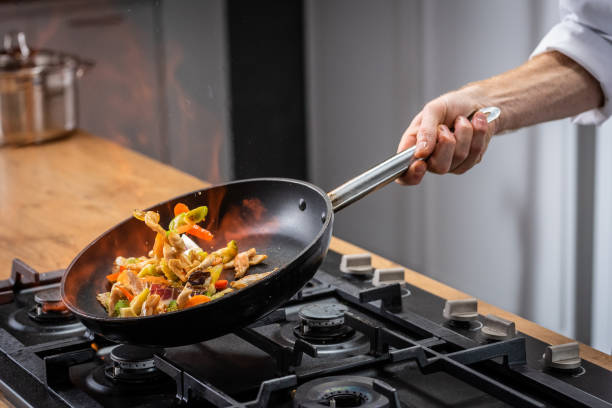
Frying pans, also known as skillets, are essential tools in a chef’s kitchen repertoire. These pans feature a wide, flat cooking surface with shallow sides and a long handle, facilitating the efficient cooking of a diverse range of dishes.
Chefs use frying pans for tasks such as frying, searing, sautéing, and even baking. They come in various sizes and materials, each offering distinct advantages.
Stainless steel frying pans are durable and versatile, suitable for high-heat cooking and creating a fond for delicious pan sauces. Cast iron frying pans are revered for their excellent heat retention and ability to develop a natural non-stick surface over time.
Non-stick frying pans are ideal for cooking delicate foods like eggs and fish without the risk of sticking. Chefs often select frying pans based on the specific requirements of the dish they are preparing, considering factors such as heat conductivity, durability, and ease of maintenance.
With their versatility and reliability, frying pans are indispensable tools for chefs, enabling them to achieve precise cooking results and delicious flavors in a wide range of culinary creations.
3. Sauté Pan
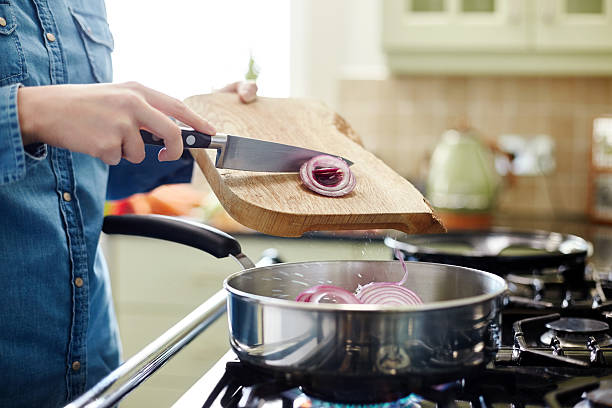
Sauté pans are indispensable tools in the arsenal of a chef, designed specifically for the technique of sautéing. These pans feature a wide, flat bottom and relatively high, straight sides, facilitating the tossing and stirring of ingredients while preventing spills and splatters.
The design allows for even heat distribution, crucial for achieving consistent cooking results. Chefs use sauté pans for a variety of cooking tasks, including searing meats, sautéing vegetables, and preparing stir-fries.
The ample surface area of sauté pans makes them versatile for cooking larger quantities of food compared to traditional frying pans, while the higher sides help contain ingredients as they are being tossed and stirred.
Sauté pans are available in various sizes, with capacities ranging from small, one-person portions to large, family-sized meals. They are typically constructed from materials like stainless steel, aluminum, or copper, chosen for their excellent heat conductivity and durability.
Some sauté pans also feature non-stick coatings, making them ideal for cooking delicate foods that may stick to the pan’s surface. With their versatility and performance, sauté pans are essential tools for chefs, enabling them to execute a wide range of culinary techniques with precision and finesse.
4. Non-stick pans
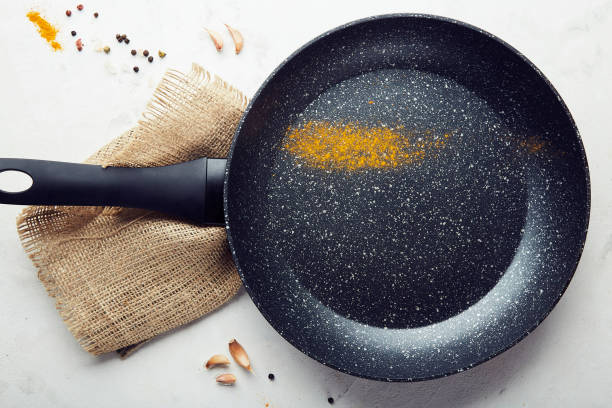
Non-stick pans are indispensable tools in the kitchen, favored by chefs for their convenience and versatility. These pans feature a smooth cooking surface coated with a non-stick material, such as Teflon or ceramic, which prevents food from sticking during cooking and makes cleanup a breeze.
Chefs often reach for non-stick pans when cooking delicate foods like eggs, fish, or pancakes, where sticking can be a common issue with traditional pans. The non-stick coating also allows for cooking with less oil or fat, promoting healthier cooking practices.
Non-stick pans come in various shapes and sizes, from small frying pans to large sauté pans and griddles, catering to a wide range of culinary needs. Chefs appreciate the ease of use and quick cleanup offered by non-stick pans, making them ideal for busy kitchen environments where efficiency is paramount.
However, it’s essential to handle non-stick pans with care to avoid scratching or damaging the coating, as this can compromise their effectiveness and longevity. With their convenience and reliable performance, non-stick pans are invaluable tools for chefs, enabling them to achieve perfect cooking results with minimal effort.
5. Skillet
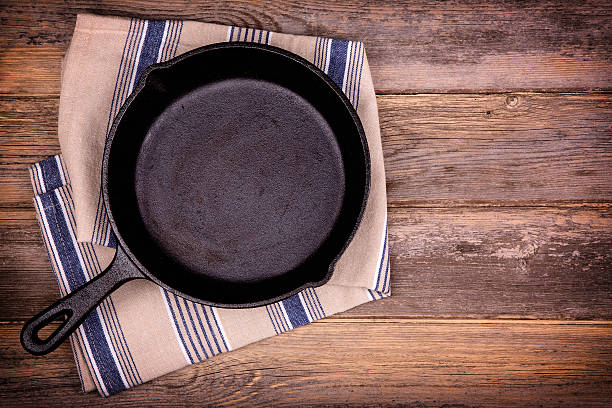
Skillets, also commonly referred to as frying pans, are versatile and essential tools in the kitchen arsenal of chefs worldwide. Characterized by their flat bottom, low sides, and long handle, skillets are designed for a multitude of cooking techniques, including frying, searing, sautéing, and even baking.
Chefs appreciate skillets for their ability to evenly distribute heat, facilitating consistent cooking results across the entire cooking surface. Skillets are available in various sizes, ranging from small 8-inch pans suitable for single servings to large 12-inch or even 14-inch pans capable of accommodating family-sized meals.
They are crafted from a variety of materials, including stainless steel, cast iron, aluminum, and copper, each offering distinct advantages in terms of heat conductivity, durability, and maintenance.
Cast iron skillets, for instance, are prized for their excellent heat retention and ability to develop a natural non-stick surface over time, while stainless steel skillets are favored for their durability and resistance to corrosion.
Chefs often have a selection of skillets in their kitchen arsenal, each chosen for specific cooking tasks and preferences. Skillets are indispensable tools for chefs, enabling them to achieve precise cooking results and develop delicious flavors in a wide range of culinary creations.
6. Brazier Pans
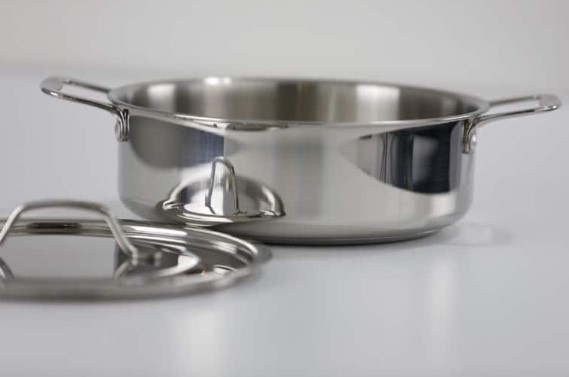
Brazier pans, also known simply as braising pans or braisers, are essential tools in the kitchen, particularly for chefs who specialize in slow-cooking techniques. These pans are characterized by their wide, flat bottoms and relatively low, straight sides, which allow for even heat distribution and ample space for ingredients.
Chefs use brazier pans primarily for the technique of braising, which involves browning meat or vegetables at high heat and then simmering them slowly in a flavorful liquid, such as broth or wine, until they become tender and infused with rich flavors.
The wide cooking surface of brazier pans makes them ideal for browning meats in batches without overcrowding, while the low sides allow for easy access when stirring or adding ingredients.
Brazier pans are typically made from materials like stainless steel or cast iron, chosen for their durability and ability to withstand prolonged cooking at high temperatures. They often come with tight-fitting lids to trap moisture and flavor during the braising process, resulting in tender, succulent dishes with concentrated flavors.
Chefs appreciate brazier pans for their versatility, as they can be used not only for braising but also for other cooking techniques such as shallow frying, stewing, and even baking.
With their ability to create flavorful, tender dishes with minimal effort, brazier pans are indispensable tools for chefs seeking to elevate their culinary creations to new heights.
7. Griddle Pans
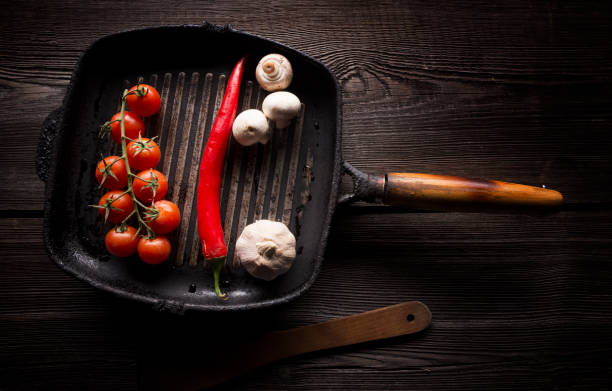
Griddle pans are versatile cooking tools that chefs frequently utilize in their culinary endeavors. These pans feature a flat cooking surface with ridges or grooves, designed to mimic the appearance of outdoor grill marks while providing the convenience of indoor cooking.
Chefs often turn to griddle pans for preparing a wide array of dishes, including meats, vegetables, sandwiches, and even breakfast items like pancakes and French toast. The ridges on the griddle surface allow excess fat and grease to drain away from the food, resulting in healthier, less oily dishes.
They impart characteristic grill lines, enhancing the visual appeal of the cooked food and adding a touch of smoky flavor. Griddle pans come in various sizes and materials, including cast iron, aluminum, and non-stick coatings, each offering distinct advantages in terms of heat retention, durability, and ease of cleaning.
Cast iron griddle pans, for instance, are prized for their excellent heat distribution and ability to develop a natural non-stick surface over time. Chefs appreciate the versatility and convenience of griddle pans, as they allow for quick and efficient cooking of a wide range of ingredients without the need for an outdoor grill.
Whether used for searing steaks, grilling vegetables, or making perfectly toasted sandwiches, griddle pans are indispensable tools in the chef’s culinary arsenal, enabling them to achieve delicious results with ease and precision.
8. Wok
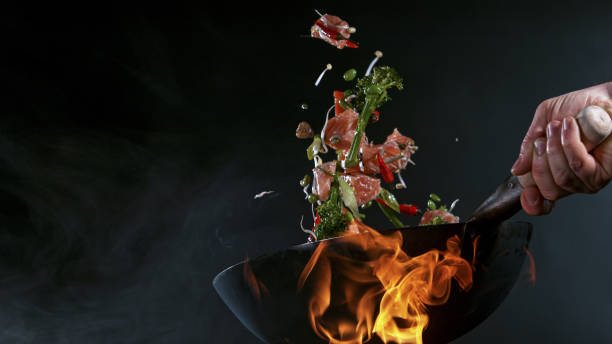
The wok is a versatile and essential cooking vessel in the kitchen, particularly in Asian cuisine, where it is a fundamental tool for stir-frying, steaming, deep-frying, and even boiling.
Characterized by its distinctive shape—a wide, rounded bottom and sloping sides—the wok is designed to distribute heat evenly, allowing for quick and efficient cooking at high temperatures.
Chefs appreciate the wok’s ability to cook ingredients rapidly while preserving their natural flavors, textures, and nutrients. The sloping sides enable chefs to toss and stir ingredients effortlessly, ensuring even cooking and preventing food from spilling over the edge.
Woks are typically made from materials like carbon steel, cast iron, or stainless steel, chosen for their excellent heat conductivity and durability. Carbon steel woks, in particular, are favored by chefs for their ability to develop a natural non-stick patina over time with proper seasoning.
Woks come in various sizes, from small, single-serving pans to large, family-sized woks used in commercial kitchens. Chefs also appreciate the versatility of woks, as they can be used on various heat sources, including gas stoves, electric ranges, and even outdoor grills.
Beyond stir-frying, woks are also used for steaming vegetables and dumplings, deep-frying crispy foods like tempura and spring rolls, and even braising meats in flavorful sauces.
With their efficiency, versatility, and ability to create delicious and nutritious meals quickly, the wok is an indispensable tool in the chef’s culinary repertoire.
9. Crepe Pan
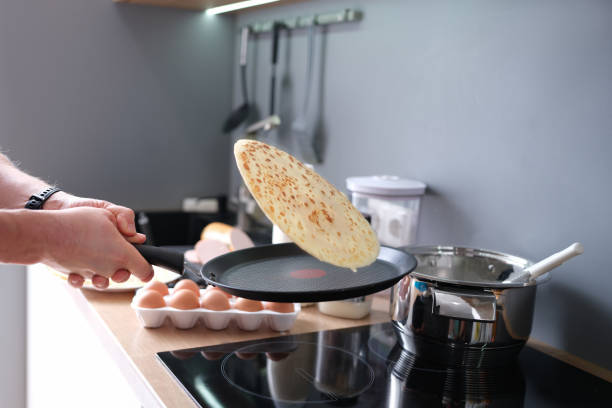
A crepe pan is a specialized kitchen tool designed specifically for cooking delicate and thin crepes. These pans typically feature a shallow, flat cooking surface with low sides and a wide diameter, allowing for easy flipping and maneuvering of the thin crepe batter.
Chefs appreciate crepe pans for their ability to distribute heat evenly across the cooking surface, ensuring that crepes cook uniformly without burning or sticking. The flat surface also enables chefs to achieve the perfect thinness and texture desired in crepes, resulting in light, tender, and evenly cooked creations.
Crepe pans are often made from materials like carbon steel, aluminum, or non-stick coatings, each offering distinct advantages in terms of heat conductivity, durability, and ease of cleaning.
Carbon steel crepe pans are prized for their ability to develop a natural non-stick surface over time with proper seasoning, while non-stick coatings provide added convenience for flipping and removing crepes from the pan.
Chefs also appreciate the versatility of crepe pans, as they can be used to cook other delicate foods such as omelets, pancakes, and even tortillas. With their specialized design and precise heat control, crepe pans are indispensable tools for chefs seeking to create perfect, restaurant-quality crepes with ease and finesse.
10. Roasting Pan
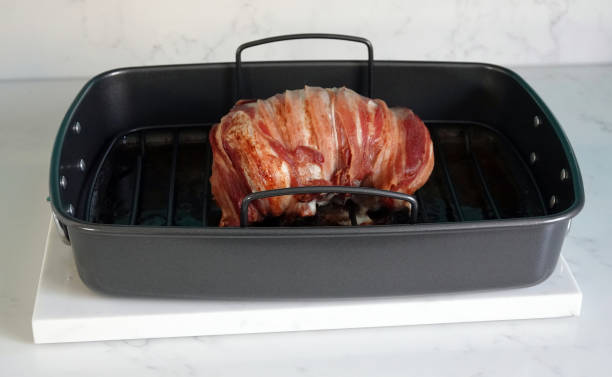
Roasting pans are essential tools in the culinary world, particularly for chefs who specialize in roasting meats, poultry, vegetables, and even large cuts of fish. These pans are specifically designed to facilitate the process of roasting, featuring a wide, shallow cooking surface with low sides and sturdy handles for easy maneuverability.
Chefs often turn to roasting pans for preparing dishes that require high heat, such as roasts and whole poultry, as the spacious cooking area allows for even air circulation around the food, ensuring that it cooks evenly and develops a flavorful, caramelized exterior.
Roasting pans typically come with a removable rack, which elevates the food above the bottom of the pan, allowing air to circulate freely and excess fat to drain away, resulting in crispy, golden-brown results.
Chefs may also use the drippings collected in the bottom of the pan to make rich gravies, sauces, or jus to accompany the roasted dish. Roasting pans are available in various sizes and materials, including stainless steel, aluminum, and enamel-coated cast iron, each offering distinct advantages in terms of heat conductivity, durability, and ease of cleaning.
Chefs appreciate the versatility and reliability of roasting pans, as they enable them to achieve perfectly cooked, succulent dishes with minimal effort, making them indispensable tools in the kitchen arsenal of any culinary professional.
6 World-Class And Famous Chefs
Certainly! Here are six world-class and famous chefs who have made significant contributions to the culinary world:
Gordon Ramsay
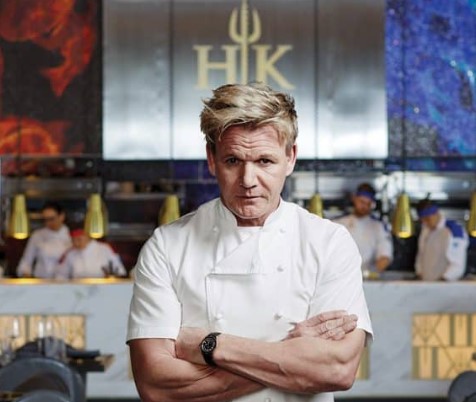
Gordon Ramsay is a globally renowned chef, restaurateur, and television personality, known for his exceptional culinary skills and fiery personality. Born in Scotland in 1966, Ramsay initially pursued a career in professional soccer before turning to the culinary world.
He trained under some of the world’s most renowned chefs, including Marco Pierre White and Albert Roux, honing his skills in classical French cuisine.
Ramsay’s breakthrough came in the late 1990s when he opened his first solo restaurant, Restaurant Gordon Ramsay, in London, which quickly earned three Michelin stars. This marked the beginning of his culinary empire, which now includes numerous successful restaurants worldwide, many of which have earned Michelin stars.
In addition to his restaurant empire, Ramsay is also a prolific television personality, starring in numerous cooking shows such as “Hell’s Kitchen,” “MasterChef,” “Kitchen Nightmares,” and “Gordon Ramsay: Uncharted.”
Known for his no-nonsense attitude and tough-love mentoring style, Ramsay has become a household name around the world, captivating audiences with his culinary expertise and entertaining personality.
Beyond his culinary and television endeavors, Ramsay is also a bestselling author, with several cookbooks to his name, and a philanthropist, supporting various charitable causes related to culinary education and children’s health.
Gordon Ramsay’s impact on the culinary world is undeniable, as he continues to inspire aspiring chefs, entertain audiences worldwide, and maintain his status as one of the most influential figures in the industry.
Wolfgang Puck
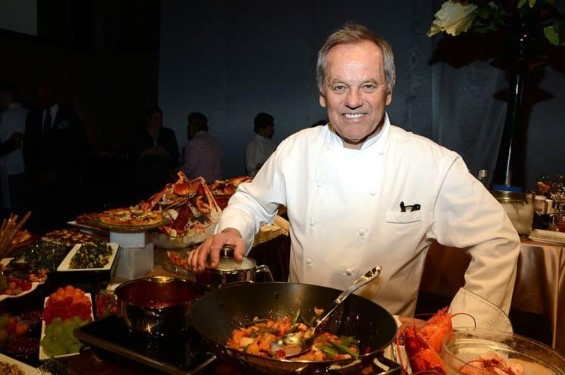
Wolfgang Puck is a pioneering chef, restaurateur, and culinary icon, recognized worldwide for his innovative approach to cuisine and his role in shaping modern American cooking. Born in Austria in 1949, Puck began his culinary journey at a young age, apprenticing in various restaurants in Europe before moving to the United States in 1973.
In 1982, Puck opened Spago, his flagship restaurant in West Hollywood, California, which quickly became a sensation and helped to revolutionize the American dining scene.
Spago’s open kitchen concept, innovative use of seasonal ingredients, and fusion of French and California cuisines garnered critical acclaim and made Puck a household name.
Beyond Spago, Puck has built an extensive culinary empire, including multiple fine dining restaurants, casual eateries, and catering services, spanning across the United States and around the world.
His restaurants, such as CUT, Chinois on Main, and Wolfgang Puck at Hotel Bel-Air, are celebrated for their creative menus, impeccable service, and vibrant atmospheres.
In addition to his restaurant ventures, Puck is a prolific cookbook author, with several bestselling titles to his name, sharing his culinary expertise and recipes with home cooks around the world. He has also appeared in numerous television shows, including cooking competitions like “Top Chef,” where he serves as a guest judge.
Throughout his career, Wolfgang Puck has been a trailblazer in the culinary world, known for his commitment to excellence, innovation, and hospitality.
His influence extends beyond the kitchen, as he has become a respected entrepreneur, philanthropist, and ambassador for the culinary arts, leaving an indelible mark on the world of food and hospitality.
Jamie Oliver
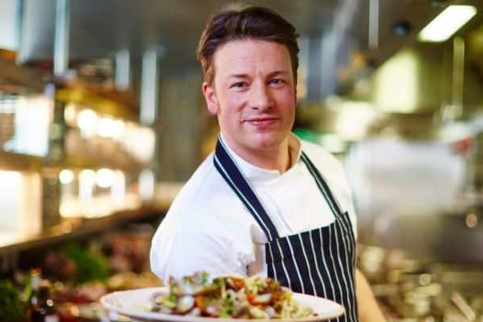
Jamie Oliver is a British chef, restaurateur, television personality, and cookbook author known for his approachable cooking style, advocacy for healthier eating habits, and efforts to tackle food-related issues such as childhood obesity and food waste.
Born in Essex, England, in 1975, Oliver gained prominence in the late 1990s with his television series “The Naked Chef,” which showcased his simple yet flavorful cooking techniques and made him a household name.
Oliver’s cooking style emphasizes fresh, seasonal ingredients and straightforward recipes that are accessible to home cooks of all skill levels. He has authored numerous bestselling cookbooks, including “Jamie’s 30-Minute Meals,” “Jamie’s Italy,” and “Jamie’s Comfort Food,” which have inspired millions of people to cook delicious meals at home.
In addition to his television shows and cookbooks, Oliver has been a vocal advocate for improving school meals and promoting healthier eating habits, particularly among children.
He launched the “Jamie Oliver’s Food Revolution” campaign, which aimed to raise awareness about the importance of nutritious food and lobbied for changes in food policies and school lunch programs.
Oliver is also a successful restaurateur, with a portfolio of restaurants around the world, including his flagship restaurant, Fifteen, which offers culinary training to disadvantaged young people.
He has received numerous awards and accolades for his contributions to the culinary world and his efforts to promote healthier eating habits and food education.
Throughout his career, Jamie Oliver has used his platform to champion important food-related causes, inspire people to cook delicious and nutritious meals at home, and advocate for positive change in the food industry.
He continues to be a leading figure in the culinary world, known for his passion for food, his commitment to making a difference, and his infectious enthusiasm for cooking.
Ferran Adria
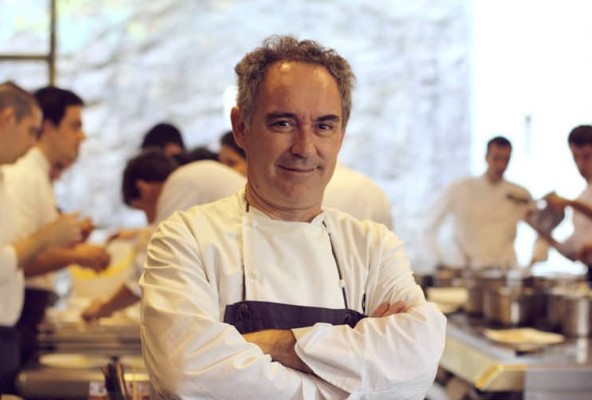
Ferran Adrià is a pioneering Spanish chef who is widely regarded as one of the most influential figures in modern gastronomy. Born in Barcelona, Spain, in 1962, Adrià rose to prominence as the head chef of elBulli, a renowned restaurant located in the Catalan region of Spain.
Under Adrià’s leadership, elBulli became a culinary mecca, earning three Michelin stars and numerous accolades for its avant-garde and innovative approach to cooking.
Adrià’s culinary philosophy was characterized by experimentation, creativity, and a relentless pursuit of culinary innovation. He and his team at elBulli pioneered techniques such as molecular gastronomy, which involved using scientific principles and cutting-edge technology to transform ingredients in unexpected ways.
Adrià’s dishes were known for their theatrical presentation, unusual flavor combinations, and intricate preparations, pushing the boundaries of what was possible in the kitchen and redefining the concept of fine dining.
Despite its acclaim, elBulli closed its doors as a traditional restaurant in 2011, but Adrià’s influence on the culinary world has continued to resonate. He has authored several books, including “A Day at elBulli” and “The Family Meal,” which provide insight into his creative process and approach to cooking.
Adrià also founded the elBulli Foundation, a nonprofit organization dedicated to culinary research, innovation, and education, ensuring that his legacy continues to inspire future generations of chefs and food enthusiasts.
Ferran Adrià’s impact on the culinary world extends far beyond his groundbreaking work at elBulli. He is revered as a visionary and a trailblazer who pushed the boundaries of gastronomy, challenged conventional notions of cooking, and forever changed the way we think about food.
His legacy as one of the greatest chefs of all time is secure, and his influence on the world of gastronomy will continue to be felt for years to come.
Marco Pierre White
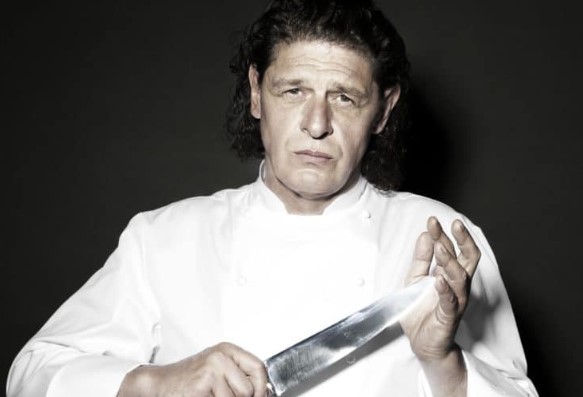
Marco Pierre White is a British chef and restaurateur who is widely regarded as one of the most influential figures in the culinary world. Born in Leeds, England, in 1961, White rose to prominence in the 1980s and 1990s as the youngest chef ever to be awarded three Michelin stars, a feat he accomplished at the age of 33.
White’s culinary career was defined by his uncompromising standards, intense passion for cooking, and innovative approach to cuisine. He trained under renowned chefs such as Albert Roux and Pierre Koffmann, honing his skills in classical French cuisine before making a name for himself as the head chef at Harveys in London.
White’s cooking style was characterized by its simplicity, elegance, and focus on high-quality ingredients. He was known for his mastery of traditional French techniques, which he combined with his own creative flair to create dishes that were both refined and memorable.
His signature dishes, such as roast pigeon with foie gras and truffle oil, became iconic symbols of his culinary prowess.
In addition to his culinary achievements, White gained fame for his larger-than-life personality and his role as a mentor to a generation of young chefs, including Gordon Ramsay and Heston Blumenthal, who went on to become culinary superstars in their own right.
Throughout his career, White has opened numerous successful restaurants, written several bestselling cookbooks, and appeared in various television shows, including “Hell’s Kitchen” and “MasterChef: The Professionals.” He has received numerous awards and accolades for his contributions to the culinary world and his role in shaping the modern restaurant industry.
Marco Pierre White’s impact on the culinary world is undeniable. He is revered as a culinary legend, a trailblazer, and a mentor to countless chefs around the world.
His influence can be felt in kitchens and restaurants everywhere, as chefs continue to draw inspiration from his innovative approach to cooking and his unwavering commitment to excellence.
Heston Blumenthal

Heston Blumenthal is a British chef known for his innovative and experimental approach to cooking, as well as his scientific exploration of gastronomy. Born in London in 1966, Blumenthal initially trained as a photocopier salesman before discovering his passion for cooking and embarking on a culinary journey that would revolutionize the culinary world.
Blumenthal’s rise to prominence began with the opening of The Fat Duck in Bray, Berkshire, in 1995. The restaurant quickly gained acclaim for its avant-garde dishes, which combined traditional British flavors with cutting-edge cooking techniques and scientific principles.
Under Blumenthal’s leadership, The Fat Duck earned three Michelin stars and was repeatedly named one of the best restaurants in the world.
Blumenthal’s cooking style is characterized by its experimental nature and meticulous attention to detail. He is known for pushing the boundaries of traditional cooking, incorporating elements of molecular gastronomy, food science, and psychology into his culinary creations.
Dishes like “Nitro-Scrambled Egg and Bacon Ice Cream” and “Sound of the Sea” exemplify his innovative and multisensory approach to dining.
In addition to The Fat Duck, Blumenthal has opened several other successful restaurants, including Dinner by Heston Blumenthal in London and The Perfectionists’ Café at Heathrow Airport.
He has also authored several bestselling cookbooks, including “The Fat Duck Cookbook” and “Heston Blumenthal at Home,” which offer insight into his creative process and approach to cooking.
Blumenthal’s influence extends beyond the kitchen; he has appeared in numerous television shows, including “Heston’s Feasts” and “Heston’s Fantastical Food,” where he showcases his inventive culinary creations and explores the history and science behind food.
Throughout his career, Heston Blumenthal has remained at the forefront of culinary innovation, challenging conventions, and redefining the possibilities of gastronomy. He is revered as a visionary chef, a pioneer of modernist cuisine, and a true original whose impact on the culinary world will be felt for generations to come.
Highly Recommended Brands Of The Pans Famous Chefs And Most Professionals Use
Highly recommended brands of pans favored by famous chefs and professionals in the culinary industry often include those known for their durability, superior heat conductivity, and overall performance. Here are some of the top brands:
- All-Clad: All-Clad is renowned for its high-quality stainless steel and tri-ply cookware, known for its excellent heat distribution and durability. Chefs often favor All-Clad for its reliability and long-lasting performance in professional kitchens.
- Le Creuset: Le Creuset is celebrated for its colorful enameled cast iron cookware, which is prized for its exceptional heat retention and versatility. Chefs appreciate Le Creuset for its ability to go from stovetop to oven seamlessly and its aesthetic appeal.
- De Buyer: De Buyer is a French cookware manufacturer known for its professional-grade carbon steel and copper pans. Chefs appreciate De Buyer for its traditional craftsmanship, excellent heat conductivity, and suitability for high-heat cooking techniques.
- Mauviel: Mauviel is another esteemed French cookware brand renowned for its high-quality copper cookware. Chefs value Mauviel for its superior heat responsiveness and precise temperature control, making it ideal for delicate cooking tasks.
- Lodge: Lodge is a leading brand for cast iron cookware, known for its affordable yet durable and reliable products. Chefs often use Lodge cast iron pans for their excellent heat retention and versatility in both stovetop and oven cooking.
- Scanpan: Scanpan is recognized for its high-quality non-stick cookware, featuring durable PFOA-free coatings that are metal utensil safe. Chefs appreciate Scanpan for its easy cleanup and superior non-stick performance, making it suitable for a wide range of cooking tasks.
- Staub: Staub is renowned for its enameled cast iron cookware, prized for its durability, heat retention, and excellent browning capabilities. Chefs often choose Staub for its ability to create flavorful and tender dishes, particularly for braising and slow-cooking.
- Vollrath: Vollrath manufactures a wide range of commercial-grade cookware known for its durability and performance in professional kitchens. Chefs appreciate Vollrath for its reliable and affordable options, suitable for high-volume cooking environments.
These brands are highly regarded by chefs and culinary professionals for their quality, performance, and reliability, making them trusted choices in both home and professional kitchens alike.
Frequently Asked Questions (FAQs) – What Pans Do Chefs Use
What makes professional chefs’ choice of pans so special?
Professional chefs often opt for pans crafted with high-quality materials and superior construction, ensuring optimal heat distribution and durability. These pans are designed to withstand the rigorous demands of a bustling kitchen, empowering chefs to create culinary masterpieces with ease.
How do premium pans contribute to a chef’s culinary prowess?
Premium pans elevate a chef’s cooking experience by providing precise temperature control and even heat distribution. This enables chefs to achieve perfect sears, delicate sautés, and exquisite caramelization, enhancing the flavor and presentation of their dishes.
What types of pans are favored by renowned chefs worldwide?
Renowned chefs worldwide often favor a variety of pans, including stainless steel, copper, and cast iron. Each type offers unique benefits, such as excellent heat retention, non-reactivity, and versatility, allowing chefs to execute diverse cooking techniques with finesse.
How do chefs select the ideal pan for each culinary creation?
Chefs meticulously select pans based on the specific requirements of their recipes, considering factors such as conductivity, responsiveness, and ease of maintenance. By choosing the right pan for each task, chefs can unleash their creativity and bring out the best flavors in every dish.
Can investing in high-quality pans enhance home cooking experiences?
Absolutely! Investing in high-quality pans can significantly enhance home cooking experiences by enabling amateur chefs to achieve professional-level results. With the right tools at their disposal, home cooks can explore new techniques, experiment with flavors, and elevate their culinary repertoire with confidence.
How do chefs maintain the longevity of their pans?
Chefs ensure the longevity of their pans through proper care and maintenance, including regular seasoning, gentle cleaning methods, and avoiding harsh abrasives. By treating their pans with respect and attention, chefs can enjoy years of reliable performance and culinary inspiration.
What role do eco-friendly pans play in modern culinary practices?
Eco-friendly pans are gaining popularity among chefs due to their sustainable materials and energy-efficient designs. By prioritizing eco-conscious options, chefs can reduce their environmental footprint while still achieving exceptional cooking results and inspiring others to adopt more sustainable culinary practices.
How do chefs adapt their choice of pans to accommodate dietary preferences and restrictions?
Chefs adeptly adapt their choice of pans to accommodate various dietary preferences and restrictions, utilizing non-stick surfaces for vegan and vegetarian dishes, or dedicated pans for gluten-free cooking. This flexibility allows chefs to cater to diverse culinary needs without compromising on flavor or quality.
Can novice cooks benefit from learning about chefs’ preferred pans?
Absolutely! Novice cooks can glean valuable insights from learning about chefs’ preferred pans, including understanding the importance of heat control, selecting the right pan for each task, and investing in durable, versatile cookware. By emulating professional practices, novice cooks can build confidence and enhance their culinary skills over time.
How do chefs view their pans as essential tools for culinary expression?
Chefs view their pans as essential tools for culinary expression, treating them with the same reverence as paintbrushes to a painter or instruments to a musician. With their pans as their canvas, chefs craft flavorful works of art, infusing each dish with passion, creativity, and a touch of their unique culinary identity.
Conclusion
In conclusion, the choice of pans in culinary endeavors is a nuanced decision influenced by various factors such as cooking technique, ingredients, and personal preference.
Through exploring the diverse array of pans utilized by chefs, from versatile stainless steel to specialized non-stick coatings and traditional cast iron, it becomes evident that each type serves a distinct purpose in the kitchen.
While there is no one-size-fits-all solution, understanding the characteristics and capabilities of different pans empowers chefs to elevate their culinary creations with precision and finesse. Ultimately, the artistry of cooking is amplified when chefs wield the appropriate tools, ensuring that every dish is executed to perfection.